A Lady Standing at a Virginal
c. 1670–1674Oil on canvas
51.7 x 45.2 cm. (20 3/8 x 17 3/4 in.)
National Gallery, London
One of the unique features of Dutch genre painting is its interest in creating realistic scenes which, paradoxically, usually have a symbolic content. Few artists created scenes as lifelike as those of Vermeer, and none were as capable of creating figures in these interiors whose mental states seem to transcend the everyday. The crystalline and realistic space of this painting acts as a vehicle for a representation of love. The association of music with love is common in early Modern Europe and is found in numerous Dutch paintings. In this case, the amorous content is confirmed through the presence of a painting of Cupid. The same painting also appears in another work by Vermeer, Girl Interrupted in Her Music and also found in the painting Girl Reading a Letter at an Open Window until the artist decided to eliminate it. The painting is a work by Cesar van Everdingen which must have belonged to Vermeer (in the inventory of his widow's possessions in 1676 a painting of this subject is mentioned). As De Jongh has indicated, the painting of Cupid was inspired by an emblem in Otto van Veen's Amorum Emblemata, published in Antwerp in 1608 which alludes to faithful love. It seems likely that by including this painting in his composition, Vermeer alludes to a concept of love which includes fidelity.
As various authors have noted, it is possible that this canvas formed a pair with the painting A Lady Seated at a Virginal, as they share similarities of subject, size and technique. In that painting the woman's smile, the presence of an unplayed viola and the painting on the end wall by Dirk van Baburen of a brothel scene (fig. 1), indicate that the artist is inviting the viewer to accompany the woman in the game of love. This is also suggested by the difference in the lighting in the two paintings: while in the present work the room is illuminated by a strong light which enters through the window, in the composition with the woman seated we are in a dosed interior, darker and more private. Vermeer may have represented two different types of love in these paintings, faithful love in A Lady Standing and a mercenary type of love in the Lady Seated.
The landscapes in the painting on the wall (fig. 4) and on the lid (fig. 3) of the virginal are both from a single painting (fig. 2) by the Delft artist Pieter Groenewegen. If they play some role in the meaning of the picture, it is possible that their presence acts as a metaphor for the purity and beauty of the woman, as found in contemporary literature.
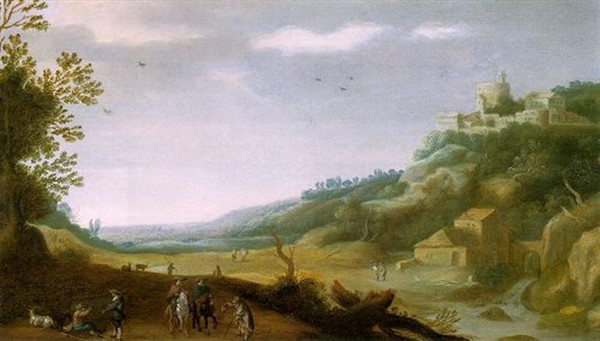 fig. 2
Mountain Landscape
fig. 2
Mountain LandscapePieter Anthonisz van Groenewegen
c. 1626
Private collection, The Hague
 fig. 3 A Lady Standing at a Virginal (detail)
fig. 3 A Lady Standing at a Virginal (detail)Johannes Vermeer
c. 1670–1674
Oil on canvas, 51.7 x 45.2 cm.
National Gallery, London
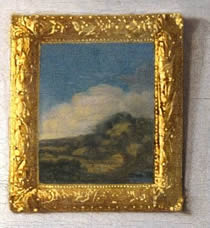 fig. 4 A Lady Standing at a Virginal (detail)
fig. 4 A Lady Standing at a Virginal (detail)Johannes Vermeer
c. 1670–1674
Oil on canvas, 51.7 x 45.2 cm.
National Gallery, London
In contrast to the diffused outlines and denser atmosphere of Vermeer's paintings of the 1660s, this work from the early 1670s is more crystalline in atmosphere, the outlines are defined with greater precision and the picture surface is smoother. However, what has not changed is the artist's skill in capturing the effects of light which enter through the window and focus our attention on the picture frames and the woman's clothes and accessories.
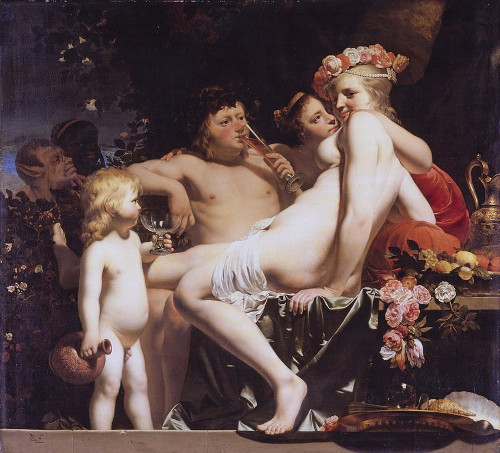 fig. 5 Bacchus with Nymphs and Cupid
fig. 5 Bacchus with Nymphs and CupidCaesar van Everdingen
c. 1660
Oil on canvas, 147 x 161 cm.
Gemäldegalerie, Dresden
The mood of Vermeer's paintings also changes around 1670: in contrast to the calm and concentration of his works of the previous decade, here the young woman's gaze and the hint of a smile suggest a more direct relationship with the viewer.
Among the most striking aspects of this wonderful painting is the harmony and clarity of the composition. The rectangular and precise forms of the windows, tiles, framed paintings, instrument and chair all echo each other, while also activating the spaces between them. The straight lines of all these elements contrast with the rounded forms of the woman and the landscapes. The exquisite ivory white of the wall is emphasized by the pale shadows which are cast by the pictures and the wall in the lower left corner and are gradually absorbed by its startling clarity.
Keyboard Instruments
Were the four keyboard instruments that Vermeer depicted all different? How many of them could Maria Thins have owned? How many could Vermeer even have seen? There were very few in Delft, or so we may infer from the fact that they crop up so rarely in inventories. I suppose there was only one in the Thins's household, a clavecin or a virginal. Vermeer was more likely to indulge his fancy painting variations on a unique object for the purpose of arriving at the precise effects he sought to achieve than he was to observe and sketch (or stare in his memory) distinct objects differing from each other in details.
The essential substratum, die Dingen an sich, in any event, must have been there: the mullioned windows, the black and white marble floors, the yellow-fringed rug, the Delft-blue tiles, the keyboard instrument. No one would have been so consistent in his choice of physical objects who did not work in their close proximity. The variations that Vermeer, like most of his contemporaries, played on these "realistic" elements were needed to enhance the beauty of the composition or to present a greater appearance of reality.
from:
John Michael Montias
Vermeer and His Milieu: A Web of Social History, Princeton, NJ: Princeton, 1989, 214–215.

H. Rodney Nevitt Jr.
"Vermeer on the Question of Love" inThe Cambridge Companion to Vermeer (Cambridge Companions to the History of Art)
2001, pp. 97–100
Cupid and the Viewer
A Lady Standing at a Virginal addresses us directly; so too does Cupid in the painting on the wall, which reappears in Vermeer's Girl Interrupted in Her Music and was initially included in the background of the Girl Reading a Letter at an Open Window before Vermeer painted it out. It has been compared to a print from Otto van Veen's emblem book, Amorum Emblemata (Emblems of Love; 1608), of Cupid holding a tablet inscribed with a "I" (fig. 6) and stepping on several tablets with other numbers to show that true love is directed to only one. Other scholars have noted that the object held by Vermeer's Cupid is in fact, blank and furthermore, there are no tablets visible on the ground. What is represented in A Lady Standing at a Virginal then is perhaps nothingm ore specific than a Cupid who greets us, to frame the woman's gaze as amorous. Vermeer's Cupid does fit into a system of references within the painting.
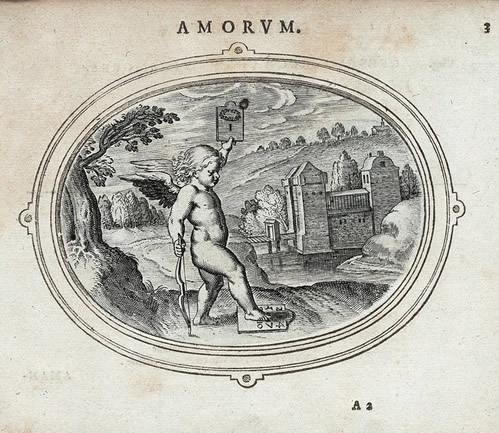 fig. 6 Perfect us Amor Est Nisi ad Unum
fig. 6 Perfect us Amor Est Nisi ad UnumEngraving from Amorum Emblemata
Otto van Veen
1608
Antwerp
Among the tiles at the bottom of the wall is at least one Cupid (fig. 9): the figure just to the left of the woman's gown, which is similar to the fishing Cupid in a print (fig. 7) from Hooft's Emblemata amatoria. Hooft's emblem plays on the conventional comparison of courtship to fishing. In Vermeer's Cupid tile, the fishing rod is visible, the proportions of the figure are consistent with Cupid, and the dark shape on his back can only be his stubby wings. (The same figure may be repeated on a tile to the right, partially obscured by the virginal's leg.) Prints like that from Hooft's book often served as patterns for tiles. Contemporary viewers who were familiar with these recurring designs on their own walls would readily have identified the Cupid in Vermeer's tile. The fishing Cupid, moreover, is part of a broader aquatic theme in the painting. Another clearly legible tile, one to the left of the Cupid, depicts a sailboat. Water appears in all three pictures-in-the-picture. A blue patch in the lower right comer of the landscape on the wall denotes a sea or lake; so too does the blue-gray area behind the Cupid in the painting. Finally, the landscape on the inner lid of the virginal includes a waterfall in the right foreground. The analogy between fishing and love, as well as the myth of Venus born from the sea, pervades Vermeer's painting, perhaps even to the extent of the pearls around the lady's neck. Watery motifs also feature prominently in Delfts Cuspidors chigger, on the title page of which Cupid aims his bow at two lovers while seated on a dolphin.
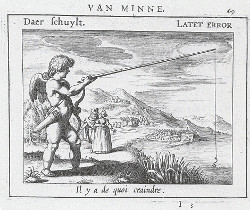 fig. 7 Illustration from Pieter Cornelisz. Hooft, Emblemata amatoria, Amsterdam,
fig. 7 Illustration from Pieter Cornelisz. Hooft, Emblemata amatoria, Amsterdam,1611
The Hague, Koninkijke Bibliotheek
c. 1675 (Dutch blue and white tile)
private collection
 fig. 9 A Lady Standing at a Virginal (detail)
fig. 9 A Lady Standing at a Virginal (detail)Johannes Vermeer
c. 1670–1674
Oil on canvas, 51.7 x 45.2 cm.
National Gallery, London
Vermeer's A Lady Standing at a Virginal fishes for us, we fish for her, or Cupid fishes for us both. One Ryder advises young women: "Learn…to steal hearts/ With Clavecin." The empty chair is for us, like the viola da gamba in A Lady Seated at a Virginal. These two paintings are merely confrontational versions of the theme of the woman with a musical instrument, whose outward gaze in other paintings is probably no less amorous. The figure in A Lady Standing at a Virginal looks down at us slightly and invites us to take a position of even greater subservience—to look up at her from the chair as she plays. We approach her then as a supplicant, a Petrarchan lover. From the chair, she would be silhouetted against the glare of the window. A song from the Tweede Delfs Cupidoos schighje (a sequel to the original songbook) poses a similar contest of lights: "...how your God-like eyes/ seek to draw hearts in/ By your bright brilliance, which conquers all/Through which Apollo's rays stand blinded." Vermeer's lady seems to wear Cupid's bow as an ornament; the intersection of the bow with her gaze conjures the metaphor:
And you, Cupid...
...must not live unarmed.
For the little EYES of my ROSELIJN:
They will provide little arrows for you again:
She is perhaps both a woman to be courted and Venus herself, to whom the beloved is often compared in poetry (the "white Mother of Love," as noted previously). Vermeer's faintly comic tone, with his cross-eyed Cupid looming triumphantly above us and the trace of a smile on the woman's face, recalls a song from Tweede Delfs Cupidoos schighje in which the foolish vrijer Pietje is confronted by, as he says, "a small little man with a bow." Pietje's female companion Trijntje warns him that he is in danger. The song ends with Pietje pleading for mercy:
Ay, ay, ay, dear Cupid
You must not slay me,
Your little arrow will hurt me so,
Stop, I will kneel before you
The Amorum Emblemata
The Amorum Emblemata is considered to be one of the most important and influential of all emblem books. The collection was designed by Otto van Veen (1556–1629) and first published in Antwerp in 1608 in three polyglot versions: Latin, French & Dutch; Latin, Italian & French (as in this copy); and Latin, English &
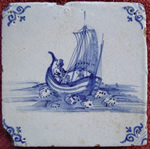 Seventeenth-century Delft floor tile
Seventeenth-century Delft floor tileIn producing a book of love emblems, Van Veen was following a trend which began in Amsterdam in 1601 with the publication of Quaeris quid sit Amor, a compilation of twenty-four love emblem prints produced by the artist Jacques de Gheyn with accompanying Dutch verses by Daniel Heinsius. Van Veen's volume is far more comprehensive, consisting of 124 emblems. The amorous maxims which accompany and interpret the pictures are mostly, but not always, taken from Ovid. Addressed to young people, the book depicts love as an overruling power which should be followed to gain happiness.
from:
Book of the Month (February 2001)
Otto van Veen
Amorum Emblemata
Gregor Weber, now head of the department of fine arts, Rijksmuseum, has long been involved in research into the paintings Vermeer incorporated in his masterpieces. Recently, he discovered that Vermeer had included the painting of Caritas Romana by an artist from the school of Dirck van Baburen in his Music Lesson in the collection of H.M. Queen Elizabeth II. In 1994 he had shown how Vermeer had used a landscape by another Delft artist, Pieter Jansz. van Asch, in his paintings of the Lady with a Guitar and the A Lady Seated at a Virginal. Clearly, Vermeer did always employ these examples literally, in fact he used some parts and left out others. New elements were not added, although Vermeer did give existing aspects more volume and accentuation. This form of borrowing was relatively common in the seventeenth century.
Quite surprisingly, it became clear that Vermeer had used Pieter Jansz. van Asch's landscape to invent two entirely different paintings. Viewing the two interpretations of Van Asch's work separately it is not immediately obvious that they are based on the same painting.
Armed with this knowledge, Weber studied the two landscapes in Vermeer's Lady Standing at a Virginal. He noted that the landscape on the wall and on the lid of the virginal showed remarkable similarities. In addition to the structure, with its succession of light and dark layers, of rocks and trees, various characteristic details, such as the roofs of the houses and the blue waterfall in the right corner were almost identical. Weber concluded that both landscapes must have been based on the same example.
For a complete investigation of the painting by Pieter Groenewegen which Vermeer reproduced on the lid of the spinet and in the painting in the gilt frame on the background wall, read the full article by Gregor J. M. Weber in the rticle "Painting Discovered in Vermeer," The Hoogsteder Journal, no. 7, Sept. 2000, pp. 10–19.
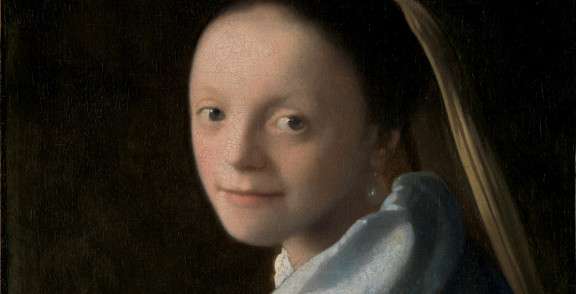
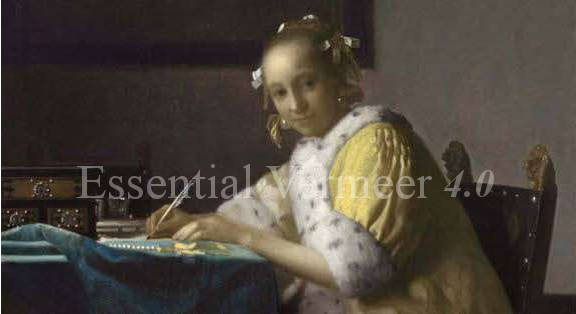



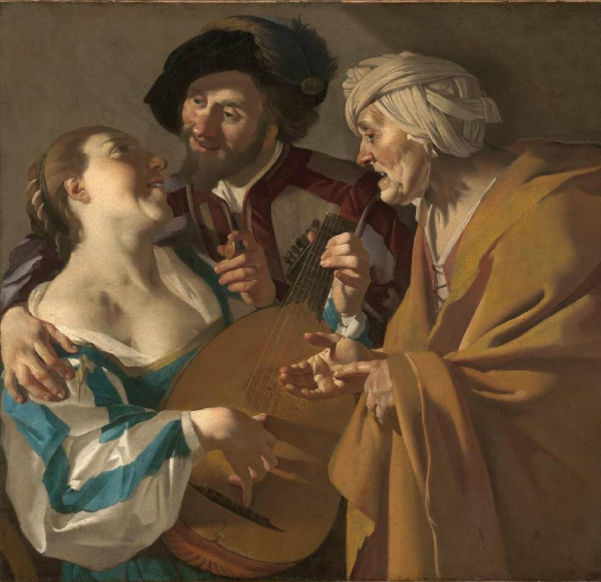
 or anything else that isn't working as it should be, I'd love to hear it! Please write me at:
or anything else that isn't working as it should be, I'd love to hear it! Please write me at: